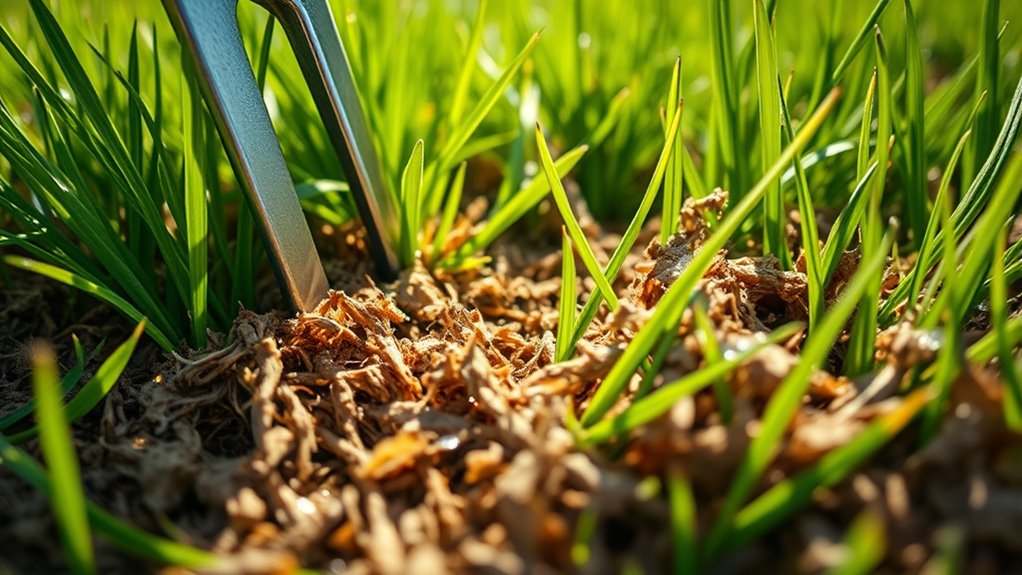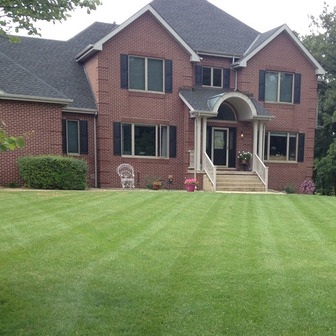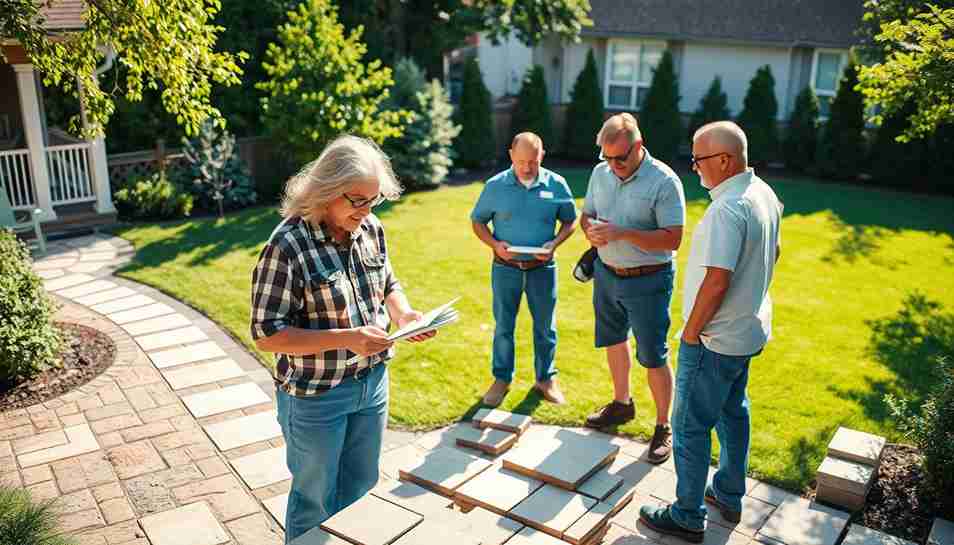What if you could cut your yard work in half while making your plants healthier? Many homeowners spend countless hours on garden upkeep. They might not realize that mulching provides a simpler, more effective way to retain moisture, suppress weeds, and enrich the soil.
We believe a beautiful outdoor space should not demand endless effort. The right approach to soil and plant care makes a huge difference. It transforms a basic yard into a thriving landscape.
This guide explores a key practice for property owners. We will show you how it protects soil moisture and regulates temperature. It also suppresses weeds and adds valuable nutrients back into the ground.
Our goal is to help you make informed choices for your property. You will learn how to select the right support and understand different material types. By the end, you will see why this is a smart investment for a healthy, beautiful environment.
Introduction to the Benefits of Mulch
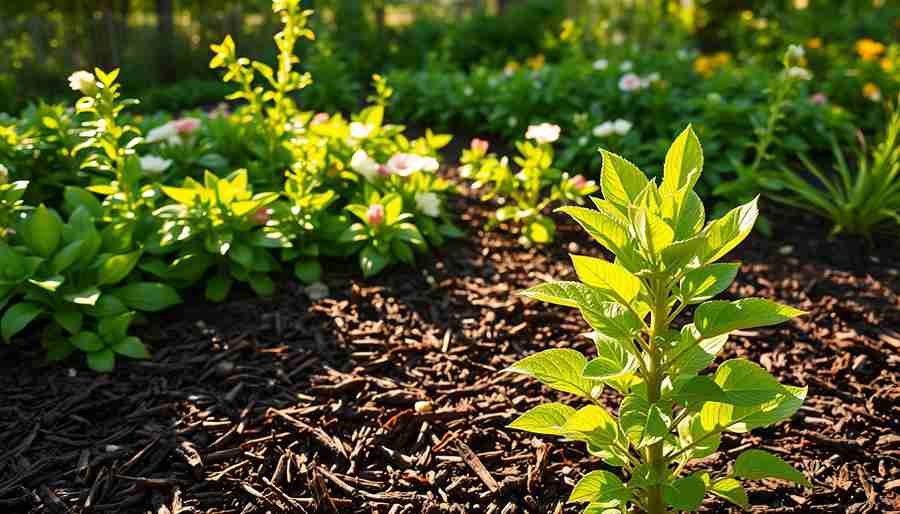
A lush, verdant garden bed bathed in warm, golden afternoon light. Vibrant green foliage and blooming flowers nestled atop a layer of rich, dark mulch. The mulch, expertly applied, forms a protective barrier that retains moisture, suppresses weeds, and insulates plant roots from temperature extremes. Sunlight filters through the canopy, casting soft shadows and highlighting the intricate textures of the mulch. In the foreground, a healthy, thriving plant stands as a testament to the benefits of this essential gardening practice. The overall scene exudes a sense of harmony, balance, and the natural cycle of growth nourished by the mulch.
Discover how this natural ground cover creates a foundation for healthier, more vibrant outdoor areas. We find that many property owners overlook the transformative power of proper soil coverage. The right approach can significantly improve your landscape’s performance.
Enhancing Lawn Health
Mulch acts as a protective layer that regulates soil temperature throughout seasonal changes. This insulation keeps plant roots cooler in summer and warmer during winter. Consistent ground conditions support better growth and reduce stress on your vegetation.
Water retention is another key advantage. The material reduces evaporation from the soil surface. This means less frequent irrigation is needed while maintaining optimal hydration for plant development.
Boosting Garden Aesthetics
Beyond functional benefits, mulch dramatically improves your garden’s visual appeal. It creates clean, finished borders around flower beds and pathways. The uniform texture provides a polished look that enhances your overall landscape design.
Organic materials gradually break down, enriching the soil with valuable nutrients. This natural process supports robust plant growth while improving soil structure over time. Your garden becomes both beautiful and biologically rich.
Understanding Different Types of Mulch
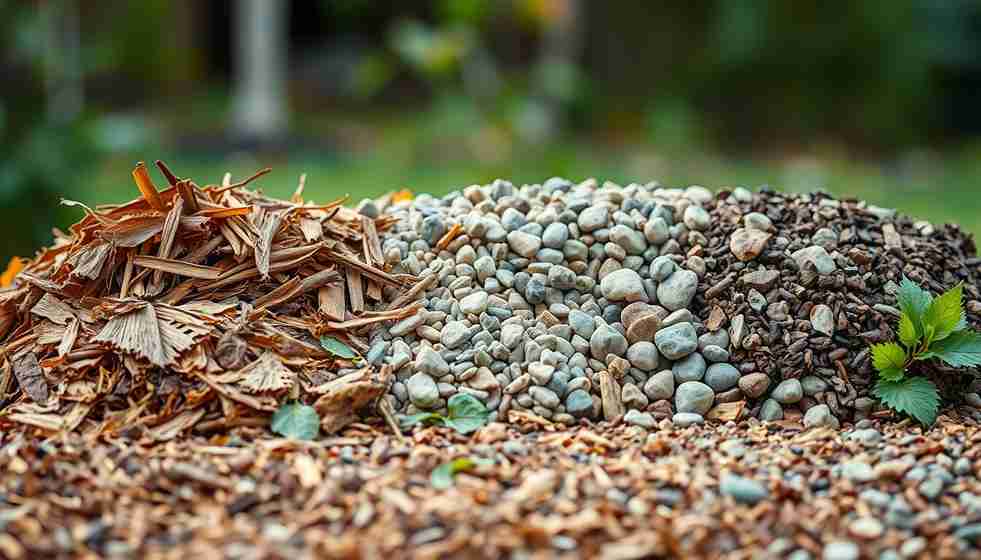
A diverse array of mulch materials arranged in a visually appealing still life composition, captured in soft, natural lighting that highlights the textures and colors. In the foreground, various types of organic mulch such as shredded bark, wood chips, and mulching leaves into lawn are neatly displayed. In the middle ground, inorganic options like gravel, river rocks, and pebbles are presented. The background features a subtle, blurred natural setting, suggesting a lush, gardening environment. The overall scene conveys a sense of tranquility and the versatility of mulching materials for lawn and garden care.
Not all landscape coverings serve the same purpose in your outdoor space. We help property owners understand that selecting the right type depends on specific needs and plant requirements.
Organic vs. Inorganic Mulch
Organic materials break down over time, enriching your soil with nutrients. These include shredded bark, wood chips, and compost. Each offers distinct advantages for different applications.
Shredded bark is quite common and easy to apply. However, it offers less nutritional value compared to compost-based materials. Grass clippings and leaves decompose quickly, adding valuable nutrients back into the ground.
Inorganic options like stone and rubber provide long-lasting coverage. They don’t decompose, making them ideal for low-maintenance areas. Understanding these differences ensures informed choices for your landscape.
Choosing the Right Material for Your Landscape
We evaluate your grass type and existing design to identify suitable materials. A thinner mulch made of grass clippings works well for vegetable gardens. It’s easier to work with around edible plants.
Your maintenance preferences and budget also influence the best choice. Household waste like leaves benefits soil but may not prevent weeds effectively. The right selection aligns with your long-term garden vision.
Finding Reliable Mulching Services Near Me
When your yard needs attention, finding trustworthy experts who deliver quality results becomes a top priority. We help homeowners identify providers with proven reliability and positive client experiences.
Evaluating Service Quality
We recommend looking for companies like C&T Lawn and Landscape with substantial customer feedback that shows consistent performance. Platforms with high ratings indicate reliable delivery.
Only the top 3% of professionals pass rigorous vetting and background checks. This ensures skilled, trustworthy workers handle your property. Detail-oriented pros with hundreds of completed jobs demonstrate the consistency homeowners need.
Insights from Customer Reviews and Ratings
Reading through customer reviews provides invaluable insights into work quality. Feedback mentioning “great job on the yard and clean up” reveals both results and service excellence.
We value providers that back their work with guarantees like the Done Right Guarantee. This offers redo or refund options within 5 days. Property protection coverage up to $2 million provides additional peace of mind.
Booking professional help takes less than 2 minutes online or by phone. This convenience makes quality care accessible even during busy schedules. Taking the time to research ensures you find providers who consistently deliver great results.
The Role of Mulching in Soil Health and Plant Growth
Beyond its neat appearance, mulch performs vital functions beneath the surface that directly fuel plant vitality. We see it as a dynamic partner for your soil, creating conditions where roots can access what they need for strong growth.
This layer is fundamental for a healthy landscape. It works continuously to support your plants’ core needs.
Improving Moisture Retention and Nutrient Delivery
A proper layer of mulch acts like a sponge and a shield. It significantly reduces water evaporation from the soil, meaning your plants stay hydrated longer. This leads to less frequent watering, saving you time and resources.
For the best results, we recommend watering and applying any needed weed control before spreading mulch. The covering then helps hold these applications in place, maximizing their effectiveness.
Organic types of mulch offer a bonus. They break down slowly, enriching the earth with valuable nutrients. This natural process feeds your plants and improves soil structure over time.
The table below summarizes how mulch supports key growth factors:
Factor | Without Mulch | With Mulch |
Water Retention | Rapid evaporation, frequent watering needed | Slowed evaporation, consistent soil moisture |
Nutrient Availability | Relies solely on fertilizer | Organic matter decomposes, adding nutrients |
Weed Pressure | High competition for water and nutrients | Suppressed weed growth, less competition |
Soil Temperature | Extreme fluctuations | More regulated, reducing plant stress |
By blocking weeds, mulch ensures your desired plants get all the water and food. This combination creates an ideal environment for robust growth and a healthier landscape.
Preparing Garden Beds for Mulch Installation
Before any mulch touches the ground, careful preparation ensures optimal results. We approach each garden bed with a systematic process that maximizes the benefits of fresh coverage. Proper groundwork prevents common issues and extends the effectiveness of your investment.
Clearing Debris and Existing Mulch
We begin every installation by thoroughly clearing the area. This involves removing old, decomposed mulch that no longer provides adequate coverage. Debris and lingering weeds are uprooted to create a clean foundation.
Our team checks if beds require watering or herbicide treatment before applying fresh material. This ensures these applications stay in place under the protective layer. A clean flower bed prevents existing weed growth from competing with your desired plants.
Optimizing Mulch Depth for Best Results
We apply mulch at optimal depths of 1-4 inches depending on the specific application. This thickness retains moisture effectively while suppressing weeds. It also allows water to penetrate the soil beneath.
For ornamental plants in flower beds, we maintain at least 3 inches of clearance from plant bases. This prevents moisture buildup that can cause rot. Vegetable gardens receive closer application to maximize moisture retention around edible crops.
We specifically avoid creating “mulch volcanoes” by not piling material against tree trunks or stems. These mounds can harbor pests and diseases. Proper installation techniques ensure your yard receives maximum benefits while avoiding plant damage.
Mulching for Trees and Shrubs
While lawns and flower beds get much attention, trees and shrubs often benefit most from strategic ground coverage. These woody plants form the permanent structure of your landscape. Proper care ensures their long-term health and beauty.
Protecting Young Trees with Proper Mulch
We create protective buffer zones around young trees using organic mulch. This prevents mulching mower damage and reduces weed competition. The material also maintains consistent soil conditions for developing root systems.
As organic materials break down, they deliver vital nutrition to support healthy growth. This is crucial during establishment years when trees are most vulnerable. We extend mulch rings to the tree’s drip line when possible.
Plant Type | Primary Benefit | Recommended Depth | Key Consideration |
Young Trees | Root protection & nutrition | 3-4 inches | Keep away from trunk base |
Established Shrubs | Temperature regulation | 2-3 inches | Coordinate with bush trimming |
Enhancing the Health of Established Shrubs
For shrubs throughout your yard, mulching regulates soil temperature and reduces water stress. It suppresses weeds that would otherwise compete for resources. This combination supports vigorous growth during dry periods.
We often coordinate mulching with professional bush trimming. This comprehensive approach addresses both soil health and plant structure. Shrubs maintain attractive shapes while roots enjoy optimal conditions.
Careful application around shrub bases prevents moisture-related problems. We avoid piling material against stems to maintain plant health. This strategic approach creates well-maintained landscape features.
Comprehensive Mulching Service Process
Professional landscape care follows a carefully orchestrated sequence that maximizes results while minimizing disruption. We streamline every step to ensure your project runs smoothly from start to finish.
From Consultation to Installation
Our process begins with a thorough assessment of your property’s specific requirements. We discuss material preferences and coverage areas to create a customized plan.
The installation phase includes proper preparation, material delivery, and expert application techniques. We handle every detail to ensure your yard receives professional care.
This systematic approach saves you a lot of time typically spent coordinating multiple contractors. Each job receives our full attention from initial planning through final cleanup.
Scheduling and Service Flexibility
We understand that timing matters for landscape projects. Our booking system allows quick scheduling through online platforms or phone calls.
Most clients can begin their project within 48 hours of booking. This rapid response ensures your job gets done when you need it most.
We offer flexible arrangements without long-term contracts. You can easily reschedule or cancel if your plans change unexpectedly.
Payment occurs only after you’ve had time to inspect the completed work. Our satisfaction guarantee provides peace of mind for every project.
Cost Considerations and Budgeting for Mulch
Smart budgeting transforms mulching from an expense into a strategic landscape investment. We help homeowners understand the financial aspects of proper ground coverage. Knowing what factors influence pricing ensures you get quality results within your budget.
Understanding Mulching Costs and Estimates
Material is typically sold by the cubic yard, with one cubic yard covering about 100 square feet at 3 inches depth. This measurement helps calculate how much mulch your project requires. Getting multiple quotes allows comparison of pricing and delivery fees.
Total project cost includes material expenses per cubic yard, delivery charges, and professional installation labor. We provide transparent quotes that itemize each component. This clarity helps identify potential savings opportunities.
Factors Affecting Cubic Yard Pricing
Several elements influence the final cost of your project:
- Material type: Basic wood chips cost less than premium cedar or dyed products
- Coverage area: Larger properties may qualify for bulk cubic yard pricing discounts
- Delivery needs: Professional mulch delivery saves multiple trips to garden centers
- Seasonal timing: Off-season purchases often yield better pricing
We calculate precise estimates by measuring your flower beds and garden areas. This determines the cubic yards needed based on recommended depth. Accurate measurement prevents over-purchasing or under-purchasing material.
Budget-conscious homeowners can reduce overall cost by choosing locally available types. Handling simpler applications yourself while hiring professionals for complex areas also optimizes spending. Proper planning ensures your landscape receives the right coverage without budget strain.
Real Landscaping Success Stories and Reviews
Nothing proves the value of professional care better than seeing actual results from satisfied homeowners. We examine real transformations that showcase how quality work elevates ordinary properties.
Client feedback reveals what matters most in landscape projects. Homeowners consistently praise professionals who deliver thorough, efficient work.
Transformations and Client Feedback
Oklahoma City reviews highlight exceptional experiences across multiple providers. Latisha M. noted a “good job” on bush trimming, while Angelica K. appreciated Curtis’s knowledge during lawn treatment.
Pam B. commended Terrance for getting the “job done fast.” Alesha B.’s review captures a common theme: “Great job on the yard and the clean up.”
These comments reflect the detail-oriented approach that defines excellent work. Professionals who combine speed with quality earn the strongest endorsements.
Professional | Rating | Jobs Completed | Satisfaction Rate |
BARRIOS lawn & landscaping | 4.91/5 | 1080 | 99% |
Benergy LLC | 4.85/5 | 424 | 98% |
Freddie MACK | 4.75/5 | 381 | 98% |
Gnome king llc | 4.64/5 | 56 | 98% |
GS Landscape | 4.39/5 | 38 | 96% |
Front yard transformations demonstrate how coordinated care creates dramatic improvements. The high percentage of tipped jobs (26-40%) indicates exceptional satisfaction.
When professionals share knowledge and maintain politeness, they build trust that leads to repeat business. These success stories validate investing in quality landscaping.
Seasonal Mulching Strategies for Optimal Results
Seasonal changes in Oklahoma City demand specific strategies for maintaining healthy landscapes. We time applications to match plant growth cycles and weather patterns. This approach maximizes benefits while reducing maintenance time.
Proper timing ensures your home’s landscaping receives protection when plants need it most. Each season presents unique opportunities to enhance your property’s appearance.
Spring and Summer Mulching Tips
Spring brings ideal conditions for refreshing tired mulch after winter. We coordinate this work with lawn mowing resumption in March or April. Fresh applications protect new plantings in flower beds.
Late April or early May offers perfect timing for comprehensive landscaping updates. Bush trimming and irrigation checks complement mulch refreshment. Summer strategies focus on moisture conservation during hot months.
We maintain adequate coverage to support lawn mowing routines. Regular checks ensure continuous protection for plant roots. This reduces watering needs during peak heat.
Fall and Winter Preparations
Fall represents a critical period for protecting perennials through winter. We schedule mulch applications before late November ground freezes. This coordinates with final lawn mowing and yard clean up.
Winter preparations include planning for early spring bush trimming. The quiet season provides time to assess future landscaping needs. Proper fall applications ensure flower beds enter dormancy well-protected.
Year-round strategies keep your yard clean and healthy across seasons. We integrate mulching with complementary services for maximum efficiency. This approach minimizes time spent on outdoor chores while maintaining optimal results.
Conclusion
Quality ground coverage stands as a cornerstone practice that bridges the gap between basic yard upkeep and professional-level results. We’ve explored how strategic mulching transforms soil health while enhancing your property’s visual appeal.
Understanding different mulch types and application techniques empowers homeowners to address specific landscape needs. This knowledge helps create optimal growing conditions for any garden or yard.
Professional landscaping services deliver expertise that saves time while ensuring superior outcomes. Investing in proper care creates lasting beauty and reduces long-term maintenance for your outdoor space.


